Wallpaper for the bathroom: types, choices and finishes
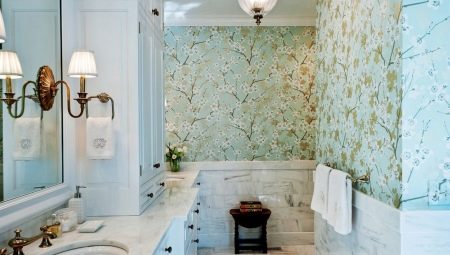
There are many materials for decorating bathroom walls. Despite the wide assortment, the choice of buyers often stops at wallpaper. From the material in this article, you will learn about the pros and cons of using this cladding, its varieties and nuances of choice.




Pros and cons of using
Wallpaper cannot be called a universal cladding material for the bathroom. The microclimate in the bathrooms is special: it is condensation, constant vapors and high humidity, splashes of water, and temperature changes. That's why the choice of wallpaper as an alternative to wall cladding is not always justified.

The advantages of using them in the bathroom include:
- aesthetic appeal;
- the widest choice of colors;
- a variety of the type of texture of the front surface;
- the ability to combine with any cladding;
- ease of gluing on bases made of different materials;
- optimal fast transformation of the room;
- undemanding care and wet cleaning;
- the ability to accentuate any interior style;
- variety of composition and type of panels;
- the ability to visually expand the space;
- giving the interior an atmosphere of home comfort;
- wide price range.
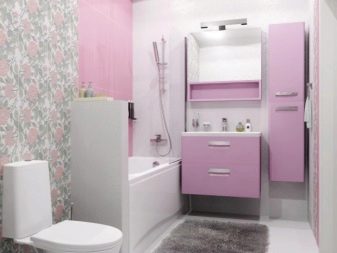



The use of wallpaper in bathrooms allows you to create absolutely any atmosphere, not limited to the choice of style, size of the pattern, the shape of the material.
This allows you to bring to life not only the usual, but also the original methods of surface cladding. Wallpaper can accentuate the walls in whole or in part. They can be used as panels, contrasting inserts on a plain or textured background.

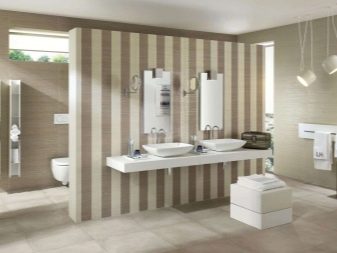
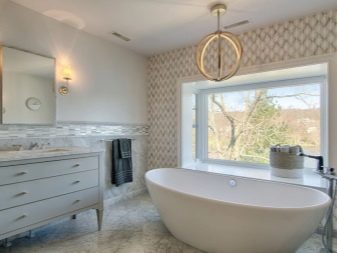
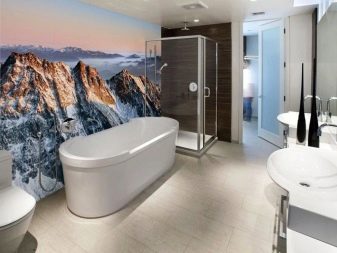
Buying and finishing is much cheaper than building materials that need tile adhesive or frame structures.
Besides, dismantling wallpaper is much easier than changing tiles or wall panels. Some of them are moisture resistant, and therefore can be used to decorate wash areas.
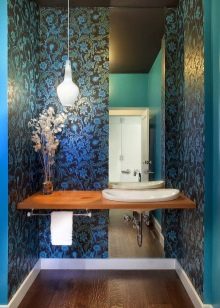


Along with the advantages, the use of wallpaper in the bathroom also has disadvantages. For example, the key ones are:
- high hygroscopicity (vapor absorption);
- lagging behind the surface (swelling from constant moisture);
- instability to fungus (the appearance of mold with poor ventilation);
- loss of a protective layer when lagging behind the surface;
- short service life;
- impossibility of gluing in wet areas of the bathroom.
Not all types of wallpaper are equally well suited for bathroom wall cladding. Some varieties very quickly lose their attractiveness, and therefore need to be re-glued.
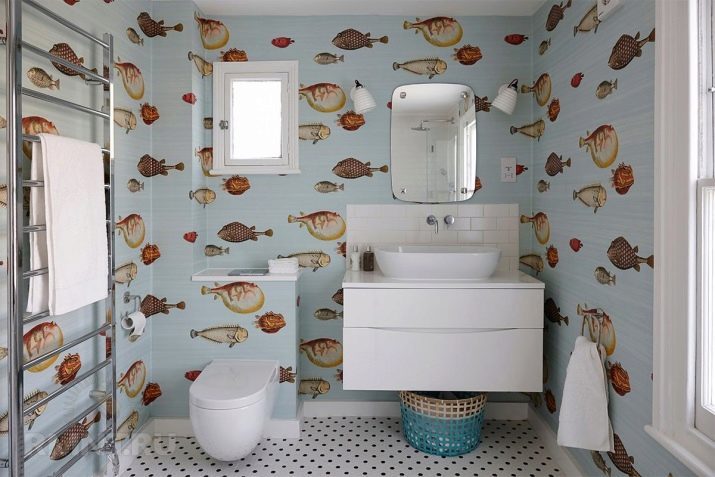
With the accumulation of moisture, other types of wallpaper material not only damp, but also swell. Due to the humid microclimate and the change in temperature, it changes the properties and glue. As a result, sometimes the canvases move away from the walls in almost solid strips. And if in large rooms it is still possible to glue wallpaper as the main cladding, then in small bathrooms this is practically impossible..



Basic requirements for wallpaper
The choice of wallpaper for the bathroom is subject to certain criteria. Unlike analogs for living rooms, these varieties should first of all be practical and durable. Decorativeness is in the background, since every day the panels will be exposed to the microclimate of the bathroom.



The main requirements for this cladding include:
- moisture resistance;
- durability;
- fixation reliability;
- antistatic;
- environmental friendliness;
- ease of care;
- aesthetics.



For bathroom wall cladding, you need to buy waterproof wallpaper.
They are inert to moisture, and therefore will stay on the walls for a long time. In this case, it is important to pay attention to abrasion resistance, as well as the possibility of adjustments or minor repairs (painting, gluing).



Varieties
From the widest range of brand offerings, only a few types of wallpaper material are suitable for bathroom decoration. Each of them differs in composition, thickness, and is designed for a certain service life.
Wallpaper can have a paper or non-woven backing.
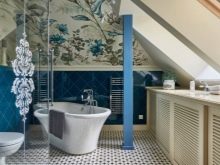


Moisture resistant wallpaper differ from other varieties by the presence of a special protective layer located on the front side of the panels. It does not allow moisture to pass through, and therefore there will be no fungus or mold under it.
These wallpapers are durable, but not breathable, and therefore they need to be glued in rooms with a well-thought-out ventilation system.
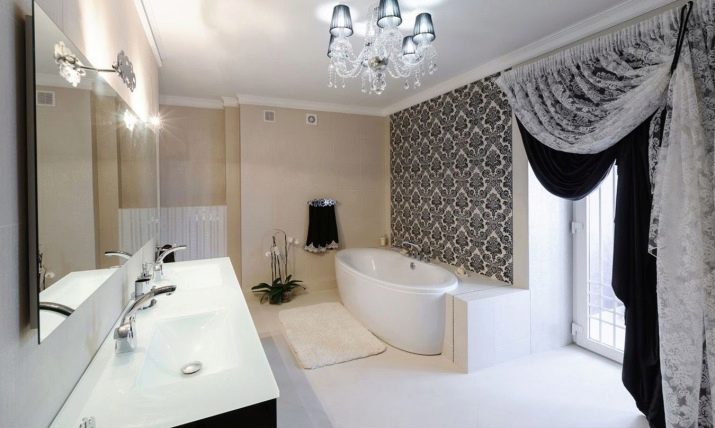
Washable wallpaper is versatile, This is a group of wallpapers designed for use in rooms with high humidity. They are durable, they can stay on the walls for about 10-15 years without the need for correction.
These panels are easy to install and dismantle, they are easy to clean with a sponge and detergents.

They are labeled with different letters:
- BB - foamed vinyl;
- PB - embossed vinyl;
- PV - flat vinyl;
- STL - fiberglass;
- STR - structural paintable.

Moreover, products can have a different class of water resistance. Indicate it on the marking in the form of lines. Each type has its own designations.
- One line indicates waterproof wallpaper. They do not include washing.
- Two lines mark a finishing material that can be cleaned with mild detergents.
- 3 lines say that the wallpaper can be cleaned with a sponge and soapy water.
- Brush and line indicate the possibility of cleaning the material with a brush and detergent.
- Brushed with 3 lines note waterproof wallpaper with high abrasion resistance.

All waterproof wallpapers are heavier than conventional wallpapers. Therefore, you need to glue them on glue for heavy wallpaper materials.
To improve adhesion, the surface of the base before gluing is treated with a deep penetration primer solution.

Vinyl
Plastic wallpaper can have a paper or non-woven backing. Due to the polymer (polyvinyl chloride), of which the top layer consists, the canvases are resistant to moisture and fumes. They are durable, withstand exposure to high temperatures, do not lose their original brightness and decorative effect for a long time.
They contain an antifungal component and are environmentally friendly.


They are glued to a special glue with a high level of adhesion. The best option for the ruler is considered to be a variety with an opaque layer that masks the unevenness of the base. Dry bathroom areas are ideal for this type of wallpaper.
The disadvantage of the finishing material is its high cost.

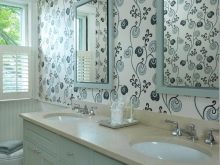
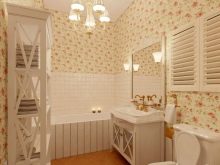
Self-adhesive
A coating of this kind is nothing more than a water-repellent film with an adhesive base on the back, on which the wallpaper is glued. They are classified as a special kind of vinyl flooring. Oilcloth wallpaper does not allow moisture to pass through, it is highly durable, durable and does not deteriorate under its influence. The material can imitate the texture of stone, wood, marble.

Self-adhesive sheets are produced in rolls of half-meter and meter width. The film is very thin, and therefore the base for gluing has to be prepared thoroughly. Gluing them to walls or doors is more difficult than conventional counterparts.
The gluing does not provide for adjustments: if the film was glued unevenly, it will not work to move it. We'll have to tear it off the wall and replace it with a new canvas.

Glass fiber
Coatings of this type are made of fiberglass material, treated with starch impregnation. They are inert to moisture, high strength and environmentally friendly. Glass fiber is purchased for gluing for painting, since they can be painted up to 25 times with special latex paint. At the same time, the texture of the panels can be very diverse.
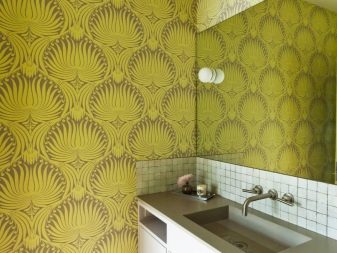


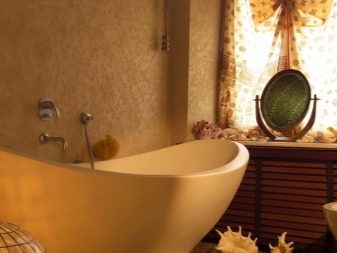
Such wallpapers cost more than their counterparts, but their price is justified by their long service life.
These are not only smooth, but also textured varieties that can convey a wide variety of textures (from matting to extraordinary ornament). They are sold in meter-wide rolls, made in a white base color. Such coatings serve for about 15 years, providing for periodic surface painting.

Liquid
This material differs from ordinary wallpaper in its appearance and method of application. It is a white or colored powder that is spread on the walls after pre-soaking. The scheme of work resembles the facing of surfaces with plaster. At the same time, if desired, a different pattern can be created on the surface. It is drawn in advance directly on the wall, and then the sections of the drawing are filled with material of different colors.

The use of liquid wallpaper in the bathroom is controversial. despite the fact that the finished finish is coated with acrylic varnish after drying. Someone thinks that they are suitable for finishing dry areas of bathrooms. Others are convinced of the impracticality of the material.
The appearance of the finished surface is distinguished by an unusual relief, powder wallpaper can be tinted, decor (sparkles, glitter, mother-of-pearl) can be included in the composition.
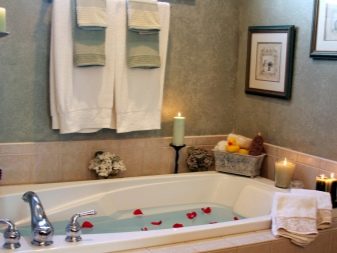

Wallpaper
In terms of design, a universal solution to accentuate certain areas of the bathroom is the use of moisture-resistant wallpaper with photo printing. This technique allows you to highlight one place in the room, making the interior expressive and fresh. The composition of such a material is different, and therefore its operational characteristics are also different.

These coverings can be washable, vinyl, self-adhesive, and are consistently popular with customers. They can be adjusted to any interior, such wallpapers are distinguished by a democratic price, immunity to ultraviolet light, ease of gluing and dismantling. They are durable and work well with a variety of bathroom cladding materials.


Styles and colors
When choosing wallpaper, not only the pattern, but also the texture is of great importance. It is thanks to her that it is possible to convey this or that feature of a particular style, increasing its recognition.


If earlier there were predominantly smooth wallpapers on store shelves, today the buyer can choose options with a realistic imitation:
- draped textiles, jeans, curtain materials;
- reptile or exotic animal skins;
- building material (stone, brick, concrete, textured plaster);
- three-dimensional drawing that changes the perception of space.

Thanks to the use of modern technologies, the texture of the front side of the wallpaper can reliably convey the shine of silk, the ebb of velvet, chipped brick, roughness of clinker and concrete. Manufacturers produce wallpaper not only of the standard, but also of the pair type. This material is convenient in that it saves the buyer from the tedious selection of shades and textures.
As a rule, companion wallpaper consists of plain and accent panels.

The choice of color scheme depends on the preferences of the buyer, the interior style, as well as the size of the room. For example, it is not customary to decorate small bathrooms with wallpaper of too bright colors. This design looks aggressive, bright colors sharply indicate the boundaries of the room, and this is unacceptable in a small space.

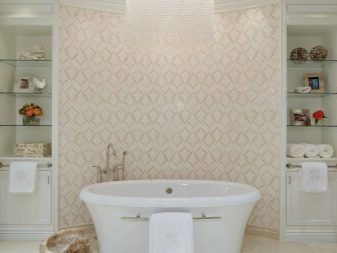
Selecting the pattern and the optimal shade of wallpaper to create a cozy atmosphere in the bathroom, you need to build on several rules:
- the wallpaper is selected taking into account the color scheme of the main finish (tiles, panels, mosaics);
- panels of light shades are taken into a small room (red, black and blue are undesirable);
- the colors of the wallpaper should not be too catchy and harsh (they violate the harmony of space perception);
- the tone of the wallpaper should overlap;
- large drawings in the bathroom are undesirable (against such a background, plumbing and furniture are lost);
- if possible, you need to combine the cladding (highlighting the accent sections of the walls is important);
- 3D wallpapers only look appropriate in a large space.




The choice of wallpaper theme must be approached thoroughly. Do not try to create a safari park or the depths of the sea out of the bathroom. You need to understand that the theme of the print affects the perception of space. Few people will be comfortable in a bathroom with walls overloaded with large photographic prints. Excessive ripples are not needed either.
When choosing a particular option, it is worth considering the degree of its relevance for a particular interior style.
For example, floral prints are relevant in country, vintage and Provence design.... However, for modern, hi-tech, art deco, such colors will not work. Here we need a plain, but textured wallpaper with an original relief.

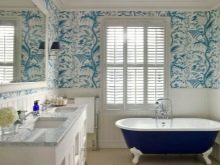

Pattern selection for different styles may vary. To make the interior look expressive and expensive, finishing material must be selected for the characteristic features of the style. In this case, it is necessary to take into account current trends. For example, for some ethnic branches of stylistics, it is appropriate to purchase wallpaper with a floral print and characteristic ornaments.

To the bathroom classic style it is worth choosing a cladding with golden monograms for decoration eastern interior - with damask patterns. Convey the atmosphere moroccan style you can use wallpaper patchwork. When you need to glue wallpaper in a bathroom style minimalism, take monochromatic coatings with a simple texture.


The best color scheme - bright... Among the current shades of the season, one can note beige, gray-blue, peach, sandy milk, creamy, mint. Fashionable combinations are contrasts of white and beige, blue with white and brown, warm green with woody and white. Also in vogue duets of beige and woody, white and black, light gray and beige, mint and white.


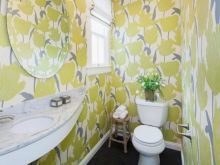
How to choose?
The choice of wallpaper for lining the walls of the bathroom must be approached thoroughly. To take the option that best fits into the intended interior style, you need to pay attention to a number of factors.... One of them will be marking: Wallpaper is by no means universal. You need to take varieties with high resistance to moisture and cleaning.
It is better to buy washable options on a non-woven substrate with a dense structure.
They can be cleaned with a cloth or soft sponge. However, do not rely on the fact that the wallpaper can be washed in the literal sense of the word. From this, spots and smudges will appear on them, while the brush will damage the texture of the front surface.

When choosing coatings for bathroom walls, you need to pay attention to their quality.
It is important to make sure that the thickness of the canvases is the same on both sides. You need to pay attention to the colors. Check for payment is taken without fail. If at home, when opening the package, a defect is found on the front side of the wallpaper, they can be exchanged or returned to the store.

If you are choosing companion wallpaper, you need to pay attention to the marking. You need to take products from one batch. This eliminates the difference in shades that are typical when buying rolls from different batches. In addition, this will allow you to select the coating as accurately as possible with the coincidence of color shades.
The choice of texture will allow you to create a special color in the interior.
For example, if a smooth surface may look rustic, then options with a grainy or embossed structure will already add a touch of high status to the background design. In addition, textured wallpaper is in vogue today. You can choose varieties with the texture of Venetian or Versailles plaster, the effect of "bark beetle" or "fur coat", chaotic strokes, diagonal or wavy relief lines.



When buying, you need to consider the status of the finishing. If the furniture and plumbing are expensive, the wallpaper is matched to them. Rustic wallpaper will make the interior tasteless. You should not take too catchy canvases. Against such a background, no plumbing, no furniture, no accessories are visible.

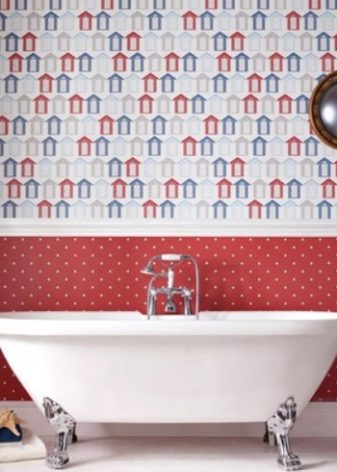
The choice can be approached from a practical point of view.
For example, in the washing area canvases look great in marble or other stone, as well as with stains or a simple pattern. In addition to floral and plant themes, current prints are monograms, herringbone, ethnic patterns and Scandinavian motifs.

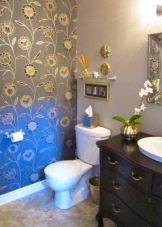


Where can you stick it?
The humidity zones of each bathroom are different. They are conventionally divided into dry and wet. And if the tiles and panels can be glued in places with more moisture, then the wallpaper in such places is not glued.
The most dangerous area is the wall above the bathroom or shower. Not a single type of wallpaper will stand here for a year. Even waterproof ones will get wet and become unusable. These walls are pasted over with tiles or panels, decorated with mosaics, less often they are painted.

The walls near the bath are considered the second most humid hazardous area. It is undesirable to glue wallpaper here, because large water splashes often fall into these places. Here you need wallpaper with special resistance to moisture and dirt (for example, glass wallpaper). The canvas must withstand regular cleaning.
The third zone is considered to be walls located at a distance of 60 cm from the sides of the bath or the edges of the shower stall. These are relatively dry areas as they rarely get sprayed. All types of waterproof wallpaper can be glued here.

Wallpaper can be pasted over the walls in those places where they cannot be sprayed with water.
For example, it can be the front door leaf, part of the wall at the location of the boiler and washing machine. The further the wallpaper is located from the washing area (bath or shower), the better. They can also be located on the wall opposite the bath or shower.

Depending on the method of gluing, wallpaper can be used to decorate a part of the wall in the area where the toilet is located. For example, if there are panels on the bottom, splashes of water will not be able to get on the wallpaper.By this principle, you can paste over the wall above the sink in the washing area. Sometimes wallpaper is pasted over the distant walls, ledges and columns of spacious bathrooms, adapted to the living rooms of the house.

Even in an interior with a free-standing bathroom, wallpaper is glued where it will be minimally affected by steam and splashes. You can paste over the canvases over the mirror. They can be used to decorate the walls near the front door, as well as partitions on the side of the dry zones of the sanitary room. In addition, they can only decorate the upper parts of the walls, leaving the rest of the space for panels or tiles.

Material combination ideas
It's no secret that wallpapers look more expressive if they have something to contrast with. The contrast finish can be different: You can combine wallpaper with panels, plastic siding, tiles, boards and painting.
However, each combination is selected individually for a specific project. When compiling it, the degree of harmony of both materials is taken into account, based on the play of texture, color, and the appropriateness of the print.


Wallpaper can be used to designate a wall in full, as well as in part, by decorating them in the form of a colorful panel, suitable for a specific interior style. They look great on the walls above, contrasting with other materials in the background.




You can combine them with different wall materials.
- Applying wallpaper at the top of the wall in the washbasin area will change the interior for the better, without reducing the practicality of the bathroom. The finish is perfectly combined with plastic sheet panels with a brickwork texture.

- Combining wallpaper with a board brings a special flavor to the bathroom interior. With a successful selection of fixtures and plumbing fixtures, the atmosphere of the old era can reign here.
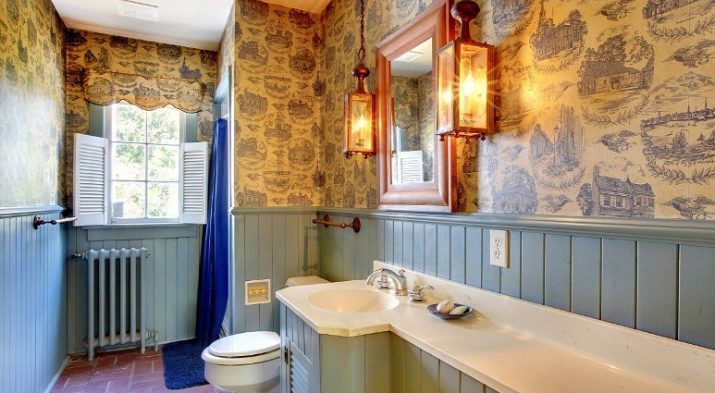
- Wallpaper with floral print, made in gentle colors, go well with ceramic tiles, decorated with a border. The harmonious choice of colors allows you to fill the interior with light, making the atmosphere as inviting as possible.

- Self-adhesive Floral Wallpaper harmoniously combined with plastic slats located in the washing area. The precise choice of colors and the selection of textures enhance the vintage effect, conveying the atmosphere of retro style.

- Practical wallpapering in the washing area with a transition to the so-called wet area. Wallpaper with monograms looks harmoniously with small tiles.

- The combination of finishing materials in the bathroom, made in neutral colors. Contrast of smooth wallpaper coating and embossed hog tiles, matte and glossy textures.

An original idea can be the use of self-adhesive wallpaper as decoration elements for the facades of wall-mounted or floor-standing cabinets.
In addition, with the help of such a material, you can create the effect of a tiled cladding. There are also ready-made cut squares from self-adhesive canvas on sale. Thanks to them, you can add a special style to the interior design of the bathroom.


Successful examples in the interior
Decorating bathroom walls with wallpaper can be not only practical, but also aesthetically pleasing. This is evidenced by examples of photo galleries.
An example of a practical design the bathroom walls with patterned wallpaper contrasting against the narrow panel slats.

Pasting wallpaper on the wall with a niche gives the bathroom an atmosphere of home comfort, visually expanding the space.
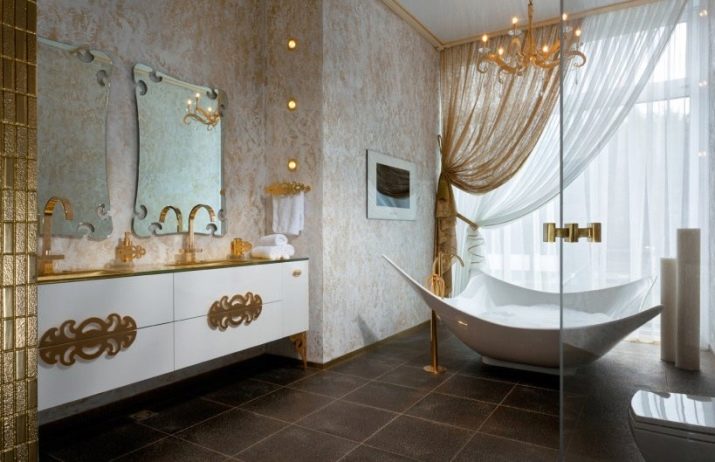
The choice of accent finishing material to decorate the wall of the bathroom located in the attic.

The creation of a special mood in the interior of the bathroom is achieved by decorating the washing area with wallpaper with birds.

The contrast between wallpaper and mosaic tiles, accentuated by a wide decorative border.

Allocation of one of the functional areas of the bathroom with bright wallpaper, gluing at the location of the dressing table.

Wall decoration of the washbasin area with bright wallpaper in retro design, contrasting against the background of plastic slats.

A good choice of wallpaper for the embodiment of retro design, harmonious combination with panels and interior accessories.

An original arrangement of wallpaper with an emphasis on practicality, adaptation of the premises to a living room.

Light wallpaper with a floral print in a bathroom with antique designs.

Wall cladding of the bathroom with wallpaper in the washbasin and toilet area, the selection of the shade of the coatings to match the furniture.

Review overview
Wallpaper is not a universal finishing material for bathroom wall cladding. This is evidenced by customer reviews left on thematic forums and information portals of the Internet. Someone thinks that they look beautiful in pictures, but in practice they are not at all so practical. At the same time, there is an opinion that after gluing they very quickly move away from the base.

Others are convinced of the opposite, noting that the canvases are quite firmly adhered to the walls of the bathroom for several years. In the comments, people write that they buy oilcloth-based wallpaper for bathroom wall decoration. In order for the wallpaper to last longer, dry the air before work, removing moisture from the working base.



In the next video, you will learn about some of the features of the bathroom wallpaper.








